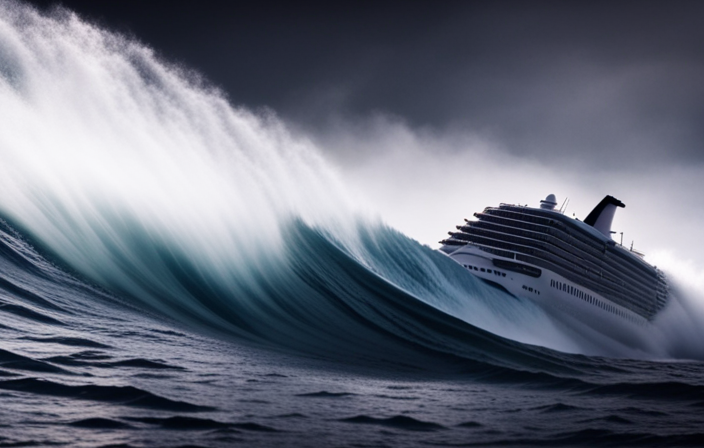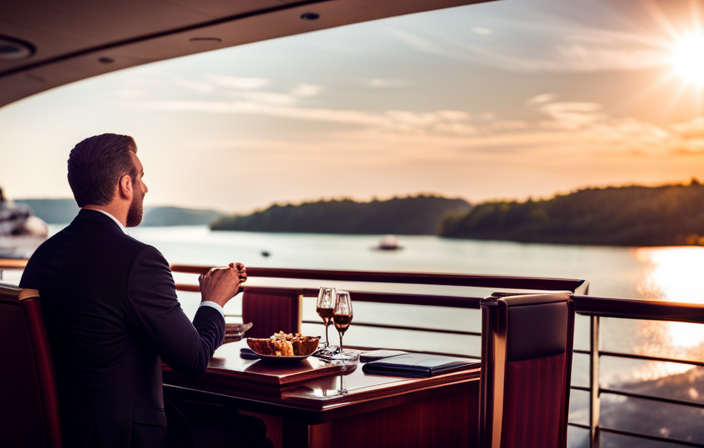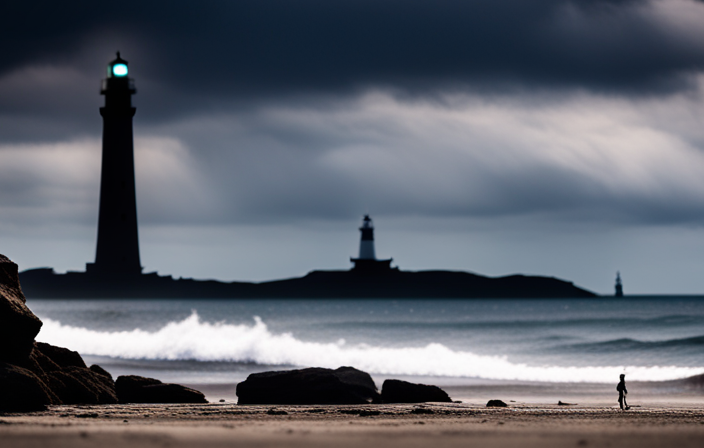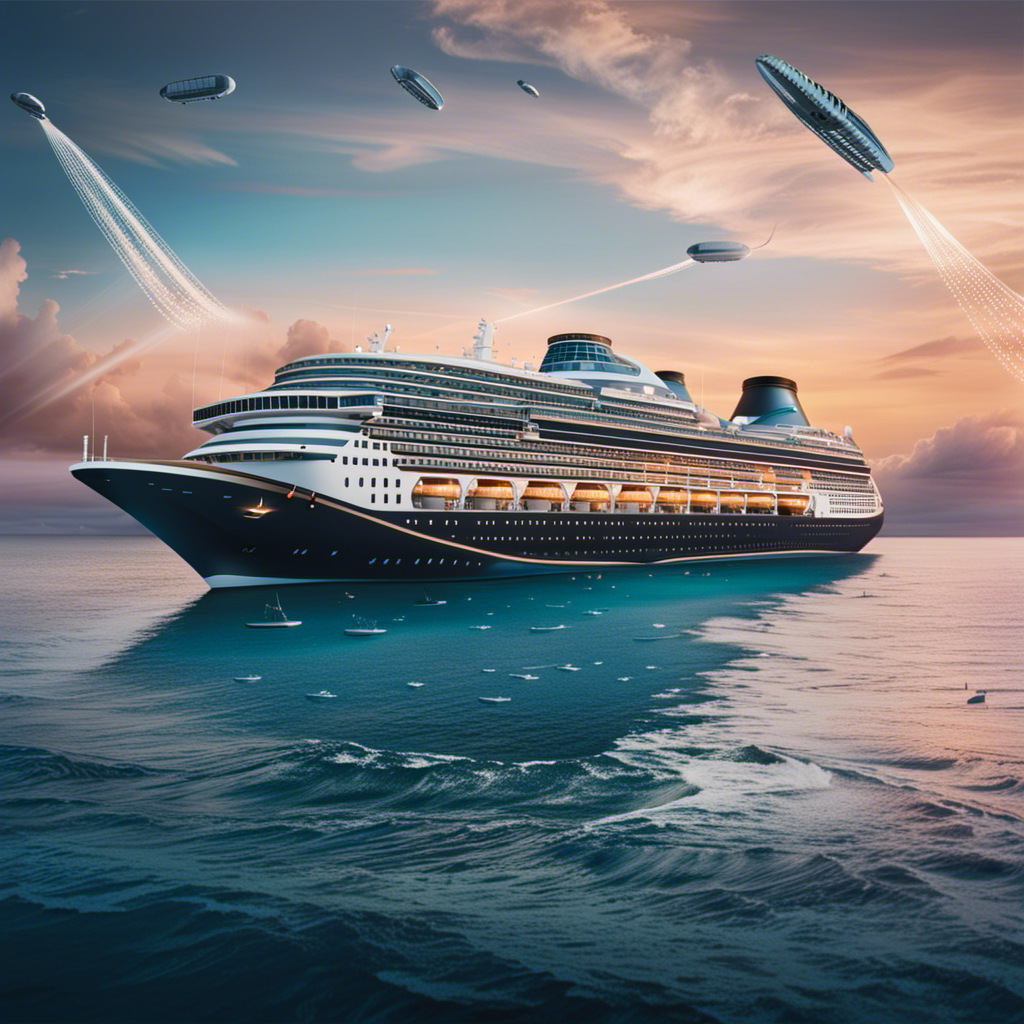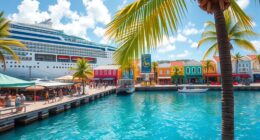Have you ever pondered the measures cruise ships implement in the midst of a hurricane?
As someone who has spent years working on these magnificent vessels, I can tell you that there is a well-established protocol in place to ensure the safety of passengers and crew.
From understanding hurricane tracking and forecasting to making necessary preparations, altering itineraries, or even canceling cruises, cruise lines take the threat of hurricanes very seriously.
In the event of a hurricane, evacuation plans are put into action, and ships may ride out the storm at sea.
Once the storm has passed, post-storm inspections and repairs are conducted, and passengers are provided with compensation and rebooking options.
Lessons are learned, and safety measures are constantly improved to mitigate the impact of future storms.
If you’re considering a cruise during hurricane season, I’ll also provide some advice to help you make an informed decision.
So, let’s dive in and explore what cruise ships truly do when faced with the fury of a hurricane.
Key Takeaways
- Cruise ships have well-established safety protocols in place for hurricanes, including monitoring weather patterns, altering course, and making informed decisions about altering itineraries or canceling trips.
- During hurricanes, cruise ships reinforce and secure their vessels by securing loose items, reinforcing windows and doors, and stocking up on necessary supplies like food, water, and emergency equipment.
- Cruise lines offer compensation and rebooking options to passengers affected by hurricanes, and continuously improve safety measures based on lessons learned from storms.
- Meteorologists play a crucial role in monitoring and predicting hurricanes for cruise ships, and cruise ships are equipped with communication protocols and equipment such as satellite phones and emergency beacons for constant communication and informed decision-making.
Understanding Hurricane Tracking and Forecasting
You’re probably wondering how cruise ships can navigate through hurricanes, right? Well, it all starts with understanding hurricane tracking and forecasting.
Cruise lines have dedicated teams of meteorologists who closely monitor weather patterns and track hurricanes as they develop. These experts use advanced technology and data analysis to predict the path and intensity of the storm.
By constantly monitoring the hurricane’s progress, cruise ships are able to alter their course and avoid the most severe weather conditions. Additionally, cruise lines have hurricane preparedness plans in place, which include conducting thorough assessments to determine the potential impact of the storm on their ships.
This allows them to make informed decisions about altering itineraries or even canceling trips altogether. By staying one step ahead of the storm, cruise ships can ensure the safety and well-being of their passengers and crew.
Preparing the Ship for a Hurricane
When preparing the ship for a hurricane, there are three key points that must be addressed.
First, I ensure that all loose items on deck are properly secured to prevent them from becoming dangerous projectiles in high winds.
Second, I reinforce all windows and doors to protect against the force of the storm.
And finally, I make sure to stock up on necessary supplies to ensure the safety and well-being of everyone on board.
These steps are crucial in ensuring the ship is well-prepared and equipped to withstand the effects of a hurricane.
Securing Loose Items on Deck
Cruise ships use various methods to secure loose items on deck, such as tying down chairs, tables, and other objects to prevent them from being blown away during a hurricane, ensuring the safety of both passengers and crew.
Securing equipment is an essential part of preparing the ship for a hurricane. To achieve this, crew members undergo thorough training on how to properly secure loose items on deck. For instance, they learn how to use heavy-duty straps and ropes to tie down furniture and other objects securely.
During Hurricane Katrina in 2005, the Carnival Cruise Line implemented strict protocols to secure loose items on deck. They removed all deck furniture and used heavy-duty straps and ropes to secure any remaining items. This ensured that nothing would become a dangerous projectile during the storm.
Now, let’s move on to the next step, which is reinforcing windows and doors.
Reinforcing Windows and Doors
To enhance the ship’s structural integrity, we crew members employ techniques like reinforcing windows and securing doors. When facing the forceful winds and powerful waves of a hurricane, it’s crucial that we reinforce the ship’s weakest points.
Windows are reinforced by installing storm shutters or covering them with protective film to prevent shattering. We also reinforce doors by ensuring they have strong locking mechanisms and using additional supports like metal bars or plywood. These measures help to prevent water from entering the ship and reduce the risk of structural damage.
Once windows and doors are reinforced, we move on to stocking up on supplies, ensuring we have enough food, water, and emergency equipment to sustain us throughout the storm. Transitioning into the next section, we prepare for any situation that may arise.
Stocking Up on Supplies
Once the ship is reinforced, we make sure to stock up on supplies, like a squirrel gathering acorns before winter, to ensure we’re prepared for any situation that may arise.
Stocking up on hurricane supplies is essential to provide for the needs of all crew and passengers onboard. Here are the three main categories of supplies we focus on:
-
Food and Water: We secure ample amounts of non-perishable food items and potable water to sustain everyone for an extended period. This includes canned goods, dried fruits, energy bars, and bottled water.
-
Medical and First Aid: We ensure that our medical facilities are fully stocked with essential medications, bandages, and medical equipment. Additionally, we have trained medical professionals ready to provide immediate assistance if needed.
-
Emergency Equipment: We gather emergency equipment such as flashlights, batteries, life jackets, and emergency rafts. These items are crucial for everyone’s safety during a hurricane.
By stocking up on these supplies, we can confidently face any challenges that may come our way during a hurricane. This level of preparedness allows us to swiftly adapt and make informed decisions about altering our itinerary or canceling the cruise if necessary.
Altering Itinerary or Canceling the Cruise
Despite the potential danger, passengers on board may feel a sense of relief as the ship’s itinerary is adjusted or the cruise is canceled altogether. Cruise lines closely monitor the development of hurricanes and make decisions based on the safety and comfort of their passengers.
In the event of severe weather conditions, cruise cancellation becomes a possibility. Rather than risking the safety of passengers and crew, alternative destinations may be considered. Cruise lines have contingency plans in place to offer passengers a similar vacation experience in a different location. These alternative destinations are carefully chosen to provide a safe and enjoyable experience while avoiding the hurricane’s path.
In the next section, we will discuss the evacuation plans for passengers and crew, ensuring their safety in the face of a hurricane.
Evacuation Plans for Passengers and Crew
When it comes to evacuation plans for passengers and crew during a hurricane, two important factors to consider are designated shelter areas and emergency communication systems.
Designated shelter areas are specific locations on the cruise ship where passengers and crew can seek refuge in the event of an emergency. These areas are strategically chosen to provide the highest level of safety and protection.
Additionally, emergency communication systems are in place to ensure that everyone on board is aware of the evacuation procedures and can quickly and efficiently communicate with each other and with the ship’s crew.
Designated Shelter Areas
Amidst the chaos of a hurricane, cruise ships create designated shelter areas where passengers can seek safety. These areas are strategically designed to protect individuals from the strong winds and turbulent seas. In addition to the main on-board shelters, cruise ships also have alternate shelter locations throughout the ship, ensuring that everyone has access to a safe space. Emergency protocols are in place to guide passengers to these designated areas, and crew members are trained to assist and direct guests during the evacuation process.
To further enhance safety, cruise ships have emergency communication systems that enable constant contact with passengers and crew. These systems ensure that important information regarding the storm’s progress, safety measures, and any necessary updates can be relayed to everyone on board. This allows for effective coordination and ensures that everyone remains informed and prepared throughout the storm. Transitioning into the next section, these communication systems play a crucial role in keeping passengers and crew connected during hurricane situations.
Emergency Communication Systems
As we discussed in the previous section, cruise ships have designated shelter areas for passengers and crew members to seek refuge during a hurricane. But what happens when communication becomes crucial in such emergency situations? That’s where the emergency communication systems come into play.
Cruise ships are equipped with state-of-the-art technology to ensure seamless communication during hurricanes. These emergency communication protocols include satellite phones, two-way radios, and even emergency beacons for distress signals. Additionally, the crew members undergo rigorous emergency response training to handle communication challenges effectively. They’re trained to relay important information to passengers, coordinate with onshore authorities, and ensure everyone’s safety.
With these systems in place, the cruise ship can maintain constant communication and make informed decisions during a hurricane.
Now, let’s delve into the next section and explore how cruise ships ride out the storm at sea.
Riding Out the Storm at Sea
While aboard a cruise ship during a hurricane, you’ll experience the incredible bravery and expertise of the crew as they navigate through treacherous seas. The riding conditions can be extremely challenging, with high winds and rough waves causing the ship to rock and sway. However, cruise ships are designed to withstand these conditions and have advanced stabilization systems in place to minimize the impact on passengers. The crew closely monitors weather updates and follows strict communication protocols to ensure the safety of everyone on board. In the event of a hurricane, the captain may alter the ship’s course or even seek shelter in a nearby port until the storm passes. This meticulous planning and execution are vital in ensuring passenger and crew safety throughout the entire journey.
Ensuring Passenger and Crew Safety
Ensuring the safety of passengers and crew during a storm at sea is like navigating through rough waters with a steady hand on the helm. When a hurricane approaches, cruise ships follow a strict set of protocols to minimize risks and keep everyone safe. Here are four crucial measures taken:
-
Crew Training: All crew members undergo extensive training on how to handle emergencies, including storm situations. They’re well-prepared to assist passengers and ensure their safety throughout the storm.
-
Communication Protocols: Clear communication is vital during a hurricane. Cruise ships have established protocols for relaying important information to passengers, allowing them to stay informed and follow instructions effectively.
-
Emergency Drills: Regular drills are conducted to familiarize everyone with emergency procedures. These drills help ensure that passengers and crew members know what to do and where to go in case of an emergency.
-
Monitoring Weather Conditions: Cruise ships have advanced technology to closely monitor weather conditions. This allows them to make informed decisions regarding routing and timing, ensuring the ship avoids the most severe parts of the storm.
As the storm subsides, the focus shifts to post-storm inspection and repairs, assessing any damage and making necessary fixes to ensure the ship’s ready for its next voyage.
Post-Storm Inspection and Repairs
Once the storm has passed, the crew conducts a thorough inspection of the ship and promptly addresses any necessary repairs. This post-storm damage assessment is crucial to ensure the safety and functionality of the ship before it sets sail again. It involves checking for any structural damage, assessing the condition of the engine and propulsion systems, inspecting the electrical and plumbing systems, and examining the integrity of the ship’s exterior.
To provide a comprehensive understanding of the inspection process, here is a table outlining the key areas inspected and the corresponding repairs:
| Area Inspected | Repairs |
|---|---|
| Structural integrity | Reinforcement or replacement of damaged sections |
| Engine and propulsion systems | Repairs or replacements as needed |
| Electrical and plumbing systems | Fixing any issues or replacing faulty components |
| Exterior | Repainting, fixing broken windows, or replacing damaged panels |
It is important to note that these repairs are typically covered by the cruise ship’s insurance policy. This coverage ensures that the necessary repairs can be made promptly and efficiently, minimizing any delays in future sailings.
As the crew completes the post-storm inspection and repairs, they also work on providing compensation and rebooking options for affected passengers.
Compensation and Rebooking Options
When it comes to compensation and rebooking options after a storm, cruise lines offer refunds and future cruise credits to passengers affected by the disruption. These options allow passengers to receive compensation for the inconvenience and have the opportunity to reschedule their cruise for a later date.
Additionally, cruise lines also assist passengers with new travel arrangements, helping them find alternative transportation and accommodations if necessary.
Refunds and Future Cruise Credits
If you decide to cancel your cruise due to a hurricane, you’ll be sailing away with a full refund or a future cruise credit, like a lifeboat of reassurance amidst the storm. Cruise lines understand the disruption and disappointment caused by a hurricane, and they aim to compensate their passengers for the inconvenience. Refunds are typically offered for the full amount paid for the canceled cruise, including any pre-paid extras like excursions or drink packages. Alternatively, future cruise credits can be provided, allowing passengers to rebook their cruise at a later date without losing their investment. These credits often come with additional perks, such as onboard credits or discounted rates. Here’s a visual representation of the available options:
| Refunds | Future Cruise Credits |
|---|---|
| Full amount paid | Rebooking at a later date |
| Including pre-paid extras | Additional perks like onboard credits |
| Discounted rates |
Now, let’s move on to how cruise lines assist passengers with new travel arrangements without skipping a beat.
Assisting Passengers with New Travel Arrangements
Get ready to set sail smoothly even after unexpected changes to your travel plans, as cruise lines are dedicated to helping you with new arrangements. When a hurricane disrupts your cruise itinerary, cruise lines have policies in place to assist passengers with refunds and future cruise credits. However, they also understand the importance of offering alternative travel options to ensure that you can still enjoy your vacation.
The rebooking process is designed to be seamless and efficient, with cruise lines working closely with their partners to find suitable alternatives for affected passengers. Whether it’s rescheduling your cruise for a later date or offering alternative destinations, cruise lines strive to accommodate your needs and preferences.
By prioritizing passenger satisfaction and safety, cruise lines have learned valuable lessons and implemented improved safety measures to ensure a smooth sailing experience for all. Transitioning into the subsequent section, let’s explore the lessons learned and the enhanced safety measures in place.
Lessons Learned and Improved Safety Measures
Improve your safety measures by learning from the lessons cruise ships have gained during hurricanes.
-
Lessons learned:
-
Enhance communication systems: Cruise ships have realized the importance of efficient communication during hurricanes. They’ve invested in advanced technology to ensure seamless communication with both passengers and emergency response teams.
-
Strengthen evacuation procedures: Through experience, cruise ships have refined their evacuation protocols. They conduct regular drills, provide clear instructions, and allocate designated assembly points to ensure a swift and organized evacuation process.
-
Implement advanced weather monitoring: Cruise lines now employ sophisticated weather tracking systems that enable them to closely monitor hurricanes and make informed decisions about itinerary changes or route alterations.
These lessons have prompted cruise ships to make significant safety improvements. By prioritizing communication, refining evacuation procedures, and utilizing advanced weather monitoring systems, they strive to provide a safer experience for passengers during hurricane season.
Transitioning to the subsequent section about advice for passengers considering cruises during hurricane season, it’s essential to understand the precautions necessary to ensure a secure journey.
Advice for Passengers Considering Cruises During Hurricane Season
Now that we’ve discussed the lessons learned and improved safety measures implemented by cruise ships during hurricanes, let me offer some valuable advice for passengers considering cruises during hurricane season.
It’s important to remember that cruise ship operators prioritize the safety and well-being of their passengers above all else. Before embarking on a cruise during hurricane season, it’s crucial to familiarize yourself with the cruise ship safety precautions. Pay attention to the weather updates and listen to the instructions provided by the ship’s crew.
Additionally, consider purchasing travel insurance that covers trip cancellations or disruptions due to hurricanes. Pack essential items such as medication, important documents, and extra clothing in case of any unforeseen circumstances.
By taking these hurricane travel tips into consideration, you can ensure a safe and enjoyable cruise experience even during hurricane season.
Frequently Asked Questions
What are the specific steps taken to prepare the ship for a hurricane?
To prepare the ship for a hurricane, specific steps are taken. These include securing loose items, reinforcing windows and doors, adjusting the course to avoid the storm, and ensuring the safety of passengers and crew.
How do cruise lines determine whether to alter the itinerary or cancel the cruise due to a hurricane?
When determining whether to alter the itinerary or cancel a cruise due to a hurricane, cruise lines rely on constant communication with passengers and crew, as well as tracking the hurricane’s path and intensity.
What are the evacuation plans for passengers and crew in the event of a hurricane?
In the event of a hurricane, cruise ships have evacuation procedures in place for passengers and crew. We are guided to designated emergency shelters on board, ensuring everyone’s safety and well-being.
How do cruise ships ensure the safety of both passengers and crew during a hurricane?
During a hurricane, cruise ships ensure the safety of both passengers and crew through a well-prepared evacuation plan. Additionally, they provide compensation to affected passengers and crew members for any inconvenience caused by the hurricane.
What options are available for compensation and rebooking for passengers affected by a hurricane-related cancellation or itinerary change?
Compensation options and rebooking options are available for passengers affected by a hurricane-related cancellation or itinerary change. Passengers may receive refunds, future cruise credits, or the opportunity to reschedule their trip.
Do Margaritaville Cruise Ships Have Special Protocols for Dealing with Hurricanes?
Yes, the margaritaville cruise ship ownership has special protocols for dealing with hurricanes. The safety and well-being of passengers and crew are top priorities. These protocols include changing itineraries, finding safe harbor, securing the ship, and keeping everyone informed.
Conclusion
In conclusion, when it comes to hurricanes, cruise ships take extensive measures to ensure the safety and well-being of their passengers and crew.
From tracking and forecasting the storm to preparing the ship and altering itineraries, cruise lines prioritize the safety of everyone on board.
Interestingly, according to the Cruise Lines International Association, only an average of 2.8% of cruises are affected by hurricanes each year.
With improved safety measures and evacuation plans in place, cruising during hurricane season can still be a rewarding and enjoyable experience for passengers.
Meet Asra, a talented and adventurous writer who infuses her passion for exploration into every word she writes. Asra’s love for storytelling and her insatiable curiosity about the world make her an invaluable asset to the Voyager Info team.
From a young age, Asra was drawn to the power of words and their ability to transport readers to far-off lands and magical realms. Her fascination with travel and cultures from around the globe fueled her desire to become a travel writer, and she set out on a journey to turn her dreams into reality.

